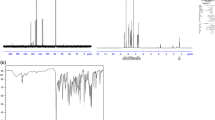Abstract
Polyurea-entrapped palladium nanoclusters have been prepared by interfacial polymerization in W/O emulsion and showed high thermal stability and chemical stability with the content of 0.12 mmol g−1 Pd. This catalyst exhibited dual catalytic activity for reduction of nitro compounds and hydrodehalogenation of aromatic chlorides in atmospheric hydrogen with 100% yield for reduction of nitro compounds and >99% yield for hydrodehalogenation of aromatic chlorides. This immobilizing method was particularly effective and eliminated the need of special chelating groups.
Similar content being viewed by others
References
Negishi EI. In Handbook of Organopalladium Chemistry for Organic Synthesis. New York: John Wiley & Sons, 2002
Chen B, Dingerdissen U, Krauter JGE, Lansink Rotgerink HGJ, Mobus K, Ostgard DJ, Panster P, Riermeier TH, Seebald S, Tacke TL, Trauthwein H. New developments in hydrogenation catalysis particularly in synthesis of fine and intermediate chemicals. Appl Catal A, 2005, 280(1): 17–46
Zawisza AM, Muzart J. Pd-catalyzed reduction of aryl halides using dimethylformamide as the hydride source. Tetrahedron Lett, 2007, 48(38): 6738–6742
Hosokava T, Murahashi SI. New aspects of oxypalladation of alkenes. Acc Chem Res, 1990, 23(2): 49–54
Niembro S, Shafir A, Vallribera A, Alibes R. Palladium nanoparticles supported on an organic-inorganic fluorinated hybrid material. Application to microwave-based Heck reaction. Org Lett, 2008, 10(15): 3215–3218
Ji HB, She YB. Green Oxidation and Reduction (in Chinese). Beijing: China Petrochemical Press, 2005
Choudhary VR, Sane MG. Poisoning of Pd-carbon catalysts by sulphur, chloro and heavy metal compounds in liquid phase hydrogenation of o-nitrophenol to o-aminophenol. J Chem Technol Biotechnol, 1998, 73(4): 336–340
Djakovitch L, Koehler K. Heck reaction catalyzed by Pd-modified zeolites. J Am Chem Soc, 2001, 123(25): 5990–5999
Okamoto K, Akiyama R, Kobayashi S. Recoverable, reusable, highly active, and sulfur-tolerant polymer incarcerated palladium for hydrogenation. J Org Chem, 2004, 69(8): 2871–2873
Zhang K, Necher DC. Diaminobipyridine-TDI polyureas: Synthesis, metal complexes, and catalytic activity. J Polym Sci, 1983, 21(11): 3115–3127
Ramarao C, Ley SV, Smith SC, Shirley IM, Dealmeida N. Encapsulation of palladium in polyurea microcapsules. Chem Commun, 2002, 10(2): 1132–1133
Bremeyer N, Ley SV, Ramarao C, Shirley IM, Smith SC. Palladium acetate in polyurea microcapsules: A recoverable and reusable catalyst for hydrogenations. Synlett, 2002, 11: 1843–1844
Yu JQ, Wu HC, Ramarao C, Spencer SV, Ley SV. Transfer hydrogenation using recyclable polyurea-encapsulated palladium: efficient and chemoselective reduction of aryl ketones. Chem Commun, 2003, 6(3): 678–679
Ley SV, Ramara C, Gordon RS, Holmes AB, Morrison AJ, McConvey IF, Shirley IM, Smith SC, Smith MD. Polyurea-encapsulated palladium(II) acetate: A robust and recyclable catalyst for use in conventional and supercritical media. Chem Commun, 2002, 10(2): 1134–1135
Ley SV, Mitchell C, Pears D, Ramarao C, Yu JQ, Zhou WZ. Recyclable polyurea-microencapsulated Pd(0) nanoparticles: An efficient catalyst for hydrogenolysis of epoxides. Org Lett, 2003, 5(24): 4665–4668
Ji HB, Kuang JG, Qian Y. Development of an immobilization method by encapsulating inorganic metal salts forming hollow microcapsules. Catal Today, 2005, 105(3–4): 605–611
Ji HB, Li JL, Pei LX, Gao JR. Low breakage and size-controlled preparation of NiCl2 immobilized hollow polyurea microcapsules. Chin J Chem Eng, 2008, 16(1): 119–123
Author information
Authors and Affiliations
Corresponding author
Rights and permissions
About this article
Cite this article
Ji, H., Long, Q., He, Y. et al. Palladium nanoclusters entrapped in polyurea: A recyclable and efficient catalyst for reduction of nitro-benzenes and hydrodechlorination of halogeno-benzenes. Sci. China Chem. 53, 1520–1524 (2010). https://doi.org/10.1007/s11426-010-4027-7
Received:
Accepted:
Published:
Issue Date:
DOI: https://doi.org/10.1007/s11426-010-4027-7




